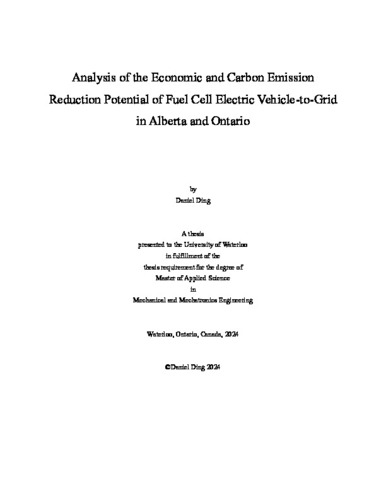| dc.description.abstract | Connecting battery electric vehicle (BEV) to the grid is a way of utilizing existing BEV fleet to cut the cost on energy storage and provide monetary incentives to vehicle owners. By coordinating the charging and discharging of the growing BEV fleet, the grid load can be shifted. Meanwhile, fuel cell electric vehicles (FCEVs) are gaining popularity, especially in heavy-duty vehicle market because of the advantages of hydrogen over battery such as the higher gravimetric density and faster refueling time. Similarly, FCEV fleet can also be connected with the grid (FCEV2G) and become moving energy generators that generate electricity and supply it to the grid using hydrogen. The hydrogen used can be produced locally with cheap and excess electricity or in a centralized production site at lower cost. A profit could be made to benefit from the high electricity price during peak hours, which can be shared among FCEV owners and the FCEV2G coordinator.
This study analyzes an FCEV2G station that can connect a few FCEVs to the grid to generate electricity. The operation, including local hydrogen production and storage, hydrogen purchased from a centralized plant, and schedules of FCEV2G, is modeled as a mixed integer linear programming problem. Using historical data of electricity price and generation mix in Alberta and Ontario, in 2019 and 2022, The profits of this FCEV2G station with different configurations are optimized and compared. Parameters including component efficiency, onsite electrolyzer are studied to investigate their impacts on the optimization result. The carbon emission potential of FCEV2G is also evaluated.
The results in Alberta show that an annual net revenue as high as 66k USD could be made in 2022 via FCEV2G, as the high and volatile electricity prices amplify the load-balancing function of FCEV2G. In addition, 185 t CO2 emission could also be avoided by using clean hydrogen to generate electricity and supply it to the carbon-intensive grid in Alberta. However, under the base case assumption, such a FCEV2G station could not make profit in 2019 in Alberta because of the efficiency losses of the electrolyzer and fuel cells as well as the relatively stable electricity price. This means, high and unstable electricity prices through a year are the key factors for FCEV2G to be profitable.
On the other hand, Ontario has abundant nuclear and hydro power supply and hence maintain a stable electricity price profile. A parametric study is conducted to study how the profitability will depend on technological improvements in the future, and it finds that, by using the 2022 data, the FCEV2G station becomes profitable after market hydrogen cost divided by fuel cell efficiency is below 86 USD/MWh. Meanwhile, the carbon intensity of electricity varies largely in Ontario because natural gas is primarily used to meet peak demands. This allows a FCEV2G pathway to reduce the carbon emissions during peak hours, and the result shows as high as 213 t CO2 emissions could be reduced in the 2022 base case. | en |

